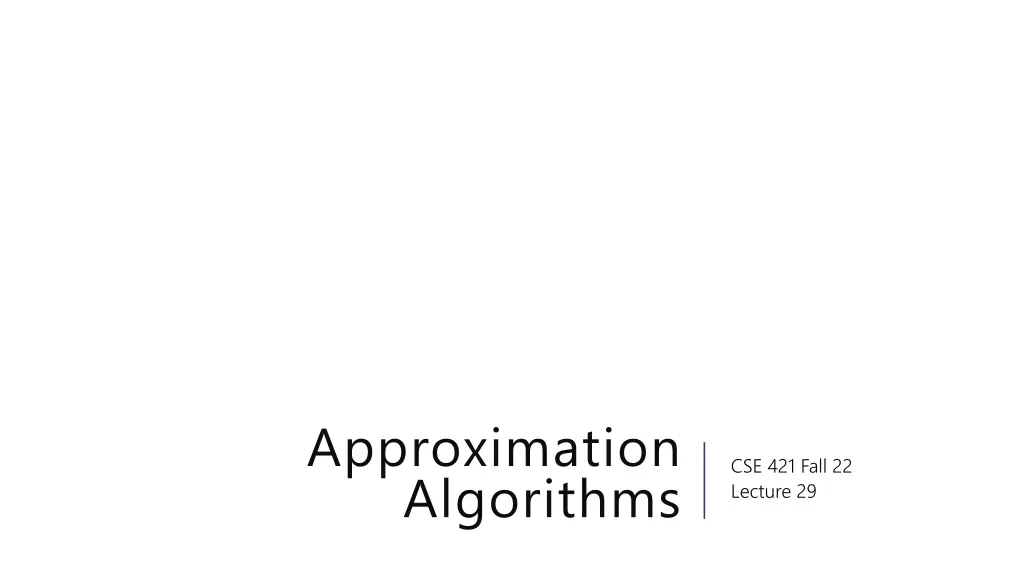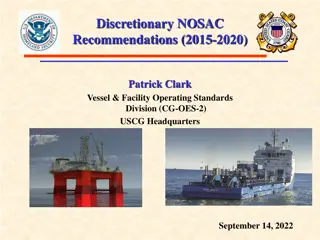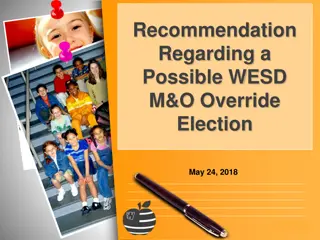
Understanding Approximation Algorithms and Ratios
Dive into the world of approximation algorithms and ratios, exploring concepts such as approximation ratios for minimization and maximization problems, the importance of approximation in finding the minimum vertex cover and maximum clique, and different techniques used in approximation algorithms. Enhance your knowledge and grasp the mnemonic techniques to remember key principles in approximation algorithms efficiently.
Download Presentation

Please find below an Image/Link to download the presentation.
The content on the website is provided AS IS for your information and personal use only. It may not be sold, licensed, or shared on other websites without obtaining consent from the author. If you encounter any issues during the download, it is possible that the publisher has removed the file from their server.
You are allowed to download the files provided on this website for personal or commercial use, subject to the condition that they are used lawfully. All files are the property of their respective owners.
The content on the website is provided AS IS for your information and personal use only. It may not be sold, licensed, or shared on other websites without obtaining consent from the author.
E N D
Presentation Transcript
Approximation Algorithms CSE 421 Fall 22 Lecture 29
Approximation Ratio For a minimization problem (find the shortest/smallest/least/etc.) If ???(G) is the value of the best solution for ?, and ???(?) is the value that your algorithm finds, then ??? is an ? approximation algorithm if for every ?, ? ??? ? ???(?) i.e. you re within an ? factor of the real best.
Approximation Ratio For a maximization problem (find the longest/biggest/most/etc.) If ???(G) is the value of the best solution for ?, and ???(?) is the value that your algorithm finds, then ??? is an ? approximation algorithm if for every ?, ??? ? ? ???(?) i.e. you re within an ? factor of the real best. ? switched sides! We want ? 1 for both maximization and minimization to make it easier to think about. If your maximization solution is half-as-good it s a 2-approximation.
Approximation Ratio If I m trying to find the minimum vertex cover, then to have a 2- approximation, I need to show: If I m trying to find the maximum clique, then the have an ?- approximation, I need to show:
Approximation Ratio If I m trying to find the minimum vertex cover, then to have a 2- approximation, I need to show: ?: 2 ??? ? ???(?) If I m trying to find the maximum clique, then the have an ?- approximation, I need to show: ?:??? ? ? ??? ? Mnemonic Mnemonic: multiply the smaller of the two numbers by something until it becomes bigger. OR: think of the ratio (ALG/OPT or OPT/ALG) that will be >1, and make it as small as possible ( it s less than 2 )
Approximation Algorithms Can easily fill an entire course Two prototypical examples (there are others!): Combinatorial approaches Techniques we ve used much of this quarter! But instead of focusing on the best aim for simple, and pretty good. LP-based approaches Write an LP round to a pretty good solution.
Recall: Finding an approximation for VC For every edge, at least one of ?,? is in the minimum vertex cover. But instead of checking which of ?,? a good idea to add, just add them both! While(G still has edges) Choose any edge (u,v) Add u to VC, and v to VC Delete u v and any edges touching them EndWhile We talked about this before. During greedy algorithms week!
Does it work? Do we find a vertex cover? Is it close to the smallest one? Does it run in polynomial time?
Do we find a vertex cover? When we delete an edge, it is covered (because we added both ? and ?. And we only stop the algorithm when every edge has been deleted. So every edge is covered (i.e. we really have a vertex cover).
How big is it? Let ??? be a minimum minimum vertex cover. Key idea: when we add ? and ? to our vertex cover (in the same step), at least one of ? or ? is in ???. Why? (?,?) was an edge! ??? covers (?,?) so at least one is in ???. So how big is our vertex cover? At most twice as big! This is a 2-approximation for vertex cover!
Another Approximation Algorithm Let s look at another approximation algorithm for vertex cover. Remember the linear program for vertex cover?
Vertex Cover LP Minimize ?? Subject to: ??+ ?? 1 for all ?,? ? 0 ?? 1 for all ?. Don t worry about the weights for today.
Non-Bipartite What if our original graph isn t bipartite? The LP finds a fractional vertex cover of weight 2.5 1 ? = 1/2 1 1 There s no real /integral VC of weight 2.5. lightest is weight 3. ? = 1/2 ? = 1/2 1 1 There s a gap between integral and fractional solutions. ? = 1/2 ? = 1/2
So, what if the graph isnt bipartite? Big idea: Just round! Pollev.com/robbie Minimize ? ? ?? Subject to: ??+ ?? 1 for all ?,? ? 0 ?? 1 for all ?. If ?? 1 2, round up to 1. If ??<1 2, round down to 0 Two questions is it a vertex cover? How far are we from the true minimum?
Is it a vertex cover? Every edge was covered in the fractional matching i.e. for every edge (?,?) ??+ ?? 1. At least one of those is getting rounded up! So every edge is covered. And we ve rounded to integers, so we have a real vertex cover.
How good of an approximation is it? Well, we might have doubled the value of the LP when we rounded. But we definitely didn t do any more than that. 2 ?? ??? And the value of the LP is definitely not bigger than the true size of the vertex cover (because otherwise the LP would have found that). ??? ?? Combining: 2 ??? ??? So we re safe in calling this a 2-approximation.
Comparing to the LP value We did a weird thing on that last slide. We were supposed to compare the value of our vertex cover to the best vertex cover. But instead we compared it to the value of the LP which we know isn t always the value of the vertex cover! That wasn t laziness, it s a very common technique. We know very little about the true value of the vertex cover (if we knew what it looked like VERY VERY precisely, why couldn t we just write an algorithm to find it? We actually won t know much). So we start with what the algorithm gave us (that we do understand).
Side Note Could we do better? Not just with the LP. If you take a graph with ?vertices and every possible edge, the LP s minimum is ?/2, the true minimum vertex cover is size ? 1. The ratio is 2 1/?. So if we don t at least double the value sometimes we won t get a vertex cover at all. sometimes Getting a 1.9999999 approximation is an open problem!
Inapproximability We can get pretty darn close to finding the best vertex cover. Other problems, we can t get close at all. And importantly we know why. For every ? > 0, there is not a poly-time approximation algorithm for MAX-CLIQUE with approximation ratio better than ?(?1 ?) Unless P = NP. There are reductions from NP-complete problems to finding a halfway- decent MAX-CLIQUE approximation
P vs. NP What does the world look like? If P = NP finding the exact maximum clique is polynomial-time solvable. So is finding a minimum vertex cover and 2-coloring. They re all easy. If P NP then these problems are fundamentally different. Max-clique is REALLY REALLY difficult; don t even expect to get close. Min Vertex Cover is difficult, but if you re willing to settle for ok, you re in really good shape. 2-coloring can be exactly solved.
One More Problem At a VERY high-level
Another Algorithm Lets try to approximate Travelling Salesperson. Traveling Salesperson Given a weighted graph, find a tour (a walk that visits every vertex and returns to its start) of weight at most ?. Some assumptions: 1. The graph is undirected. 2. The graph is complete (every edge is there) the edges might represent series of roads rather than individual streets. Weight is how much gas you need to travel. 2. The weights satisfy the triangle inequality (it s faster to go from ? to ? directly than it is to go from ? to ? through ?).
TSP starting point What would be a good baseline? Something we can can calculate that would at least connect things up for us. A Minimum Spanning Tree! A 3 4 5 5 B D 6 3 4 3 4 C E 2
From MST to Tour A 3 How do we get from start to every vertex and back? Make the starting point the root, do a traversal (DFS) of the graph! 4 5 5 B D 6 3 4 3 4 C E 2 Why not BFS? Because the next vertex isn t always right next to you! (not a problem in this example, but very bad if you have a very tall tree) How much gas do we use in DFS? We use each edge twice If ? is the starting point: Go from ? to ?, back to ? To ? Down to ? back to ? to ? Back to ? back to ?.
Doing a Little Better Using each edge twice is potentially a little wasteful. Can we do better? The biggest problem is vertices of odd degree. The last time we enter that vertex, the only way out is an already used edge. And that s definitely not taking us somewhere new! A 3 4 5 5 B D 6 So lets add some possible ways out. 3 4 3 4 C E 2
What would help? A 3 4 5 5 B D 6 A matching would help! (i.e. a set of edges that don t share endpoints) Specifically a minimum weight matching. 3 4 3 4 C E 2 You can find one of those efficiently (just trust me) Add those edges in (if they re already in the MST, make an extra copy)! A 3 4 5 5 B D 6 3 So we now have the MST AND the minimum weight matching on the odd edges. 4 3 4 C E 2
A Did It Help? B D So now every vertex has even degree but there s not a nice order anymore. We ll have to find one. C E A Start from the starting point, and just follow any unused edge! Because every vertex has even degree, (except for the starting vertex) when you go in, you can come out! So you can t get stuck What if you get back to the start and end up with unused edges? Find a visited vertex one is adjacent to and splice in the cycles. B D C E D,A,B,E,D is found first. E,C,E found next. After splicing: D,A,B,E,C,E,D. is the final tour
Is it a good approximation algorithm? We will visit every vertex at least once! Every vertex had degree at least one (because we started with an MST!) So by the end of the process, we had degree at least two on every vertex. And we go back and use all the edges we selected. So we visit every vertex, and we start and end at the same place.
Is it a good approximation algorithm? What does our algorithm produce? At most 3 Why? We use every edge once, that s one ??? plus the weight of the matching. How much is the ???? Less than ???. (??? has a spanning tree inside it!) How much is the matching? Less than 1 the odd vertices, and a tour on the odd vertices is made up of two matchings) 2??? (at most 1.5 times the weight of the optimal tour) 2???. (??? is less than a tour on
Approximating TSP We found a 3 The algorithm is called Christofides Algorithm It s almost 50 years old. 2-approximation for TSP! The best approximation is 3 Developed by three researchers at UW in the last two years https://arxiv.org/pdf/2007.01409.pdf 2 ? where ? 10 36 in the last two years.
Summary Coping with NP-hardness. 1. Understand your problem really well (make sure you re not solving an easy special case). 2. Prove the problem really is NP-hard. 3. Try a band-aid (SAT library, Integer programming library, etc.) 4. Try to find a good-enough exponential time algorithm or an approximation algorithm.








